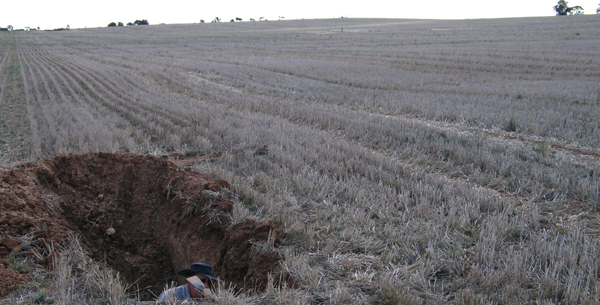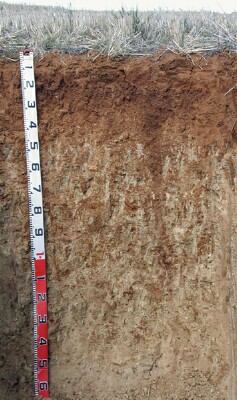NTF2
| Location: Corack East | Aust. Soil Class.:Calcic, Mesonatric, Red SODOSOL |
| General Landscape Description: Lower slope of lunette. Black Box on flats at foot. Undulations (rills) on lower slope (30-50 cm deep). | |
| Site Description: Lower Slope. | |
| Geology: Lunette deposits | Aspect: 2% |
| Vegetation: Buloke (isolated) | |
 NTF2 Landscape |
Soil Profile Morphology
Surface Soil
| A1 | 0-10 cm | Reddish brown (5YR4/4); sandy clay loam; weak coarse-medium subangular blocky structure; firm consistence (dry); slightly sub-plastic; pH 8.9; sharp change to: |  NTF2 Profile |
| A12 | 10-18 cm | Reddish brown (5YR4/4); light medium clay (sandy); massive; strong consistence (dry); sub-plastic; pH 7.4; abrupt change to: | |
| Subsoil | |||
| B21 | 18-30 cm | Yellowish red (5YR5/6); heavy clay; strong medium subangular blocky; parting to fine polyhedral structure; very firm consistence (dry); very few (<2%) medium (2-6 mm) soft calcareous segregations; pH 8.8; abrupt change to: | |
| B22 | 30-45 cm | Reddish yellow (7.5YR6/6) with distinct yellowish red (5YR5/6) mottles common (20%); medium heavy clay; weak coarse prismatic, parting to strong coarse-medium subangular blocky structure; very firm consistence (dry); pH 9.0; gradual change to: | |
| B31 | 45-60 cm | Yellowish red (5YR5/6) with many (40%) prominent light grey (10YR7/1) mottles; light clay (fine sandy); weak coarse prismatic, parting to strong medium subangular blocky and moderate fine subangular blocky structure; strong consistence (moderately moist); very few (<2%) medium (2-6 mm) soft calcareous segregations; pH 9.1; gradual change to: | |
| B32 | 60-110 cm | Pale red (2.5YR7/2) with few (3%) prominent yellowish red (5YR5/6) mottles; light clay (moderate sand); weak coarse prismatic, parting to strong coarse-medium subangular blocky structure; very firm consistence (moderately moist); medium (2-6 mm) argillaceous tubules common (10-20%) and few (<2%) medium (2-6 mm) soft calcareous segregations; old root lines filled; pH 9.1; gradual change to: | |
| B33 | 110-130 cm | Light reddish brown (2.5YR7/3) with prominent yellowish red (5YR5/6) mottles common (10%); light clay (moderate sand); weak coarse prismatic, parting to strong to moderate coarse-medium subangular blocky structure; very firm consistence (dry); few (2-10%) medium (2-6 mm) argillaceous tubules and few (2-10%) medium (2-6 mm) soft calcareous segregations; old root lines filled; pH 9.0; gradual change to: | |
| B34 | 130-160+ cm | Very pale brown (10YR7/3) with prominent yellowish red (5YR5/6) mottles common (10%); sandy clay loam; weak coarse prismatic, parting to moderate coarse subangular blocky structure; very firm consistence (dry); very few (<2%) medium (2-6 mm) argillaceous tubules and very few (<2%) medium (2-6 mm) soft calcareous segregations; pH 9.4. | |
Key Profile Features
|
Key Profile Characteristics
pH | Salinity Rating | |||
Surface (A1 horizon) | Strongly Alkaline | Very Low | Non-Sodic | None |
Subsoil (B21 horizon) | Strongly Alkaline | Low | Strongly Sodic | Strong-Complete |
Deeper subsoil (at 130-160+ cm) | Very Strongly Alkaline | High | Strongly Sodic | Slight |
 |
Horizon | Horizon Depth | pH (water) | pH CaCl2 | EC 1:5 | NaCl | Exchangeable Cations | |||
Ca | Mg | K | Na | ||||||
meq/100g | |||||||||
A1 | 0-10 | 6.7 | 6.4 | 0.17 | 7.1 | 2.0 | 1.7 | 0.32 | |
A12 | 10-18 | 7.4 | 6.3 | 0.09 | 6.4 | 3.7 | 0.72 | 1.0 | |
B21 | 18-30 | 8.8 | 7.7 | 0.39 | 0.02 | 11 | 15 | 1.8 | 7.9 |
B22 | 30-45 | 9.0 | 8.2 | 1.2 | 0.11 | 6.0 | 13 | 1.7 | 12 |
B31 | 45-60 | 9.1 | 8.3 | 1.2 | 0.13 | 5.5 | 13 | 1.6 | 12 |
B32 | 60-110 | 9.1 | 8.4 | 1.7 | 0.26 | ||||
B33 | 110-130 | 9.0 | 8.4 | 1.8 | 0.28 | ||||
B34 | 130-160+ | 9.4 | 8.5 | 0.99 | 0.14 | ||||
Horizon | Horizon Depth | Boron mg/kg | Field pF2.5 | Wilting Point pF4.2 | Coarse Sand (0.2-2.0mm) | Fine Sand (0.02-0.2mm) | Silt (0.002-0.02mm) | Clay (<0.002mm) |
A1 | 0-10 | 1.4 | 16.3 | 7.5 | 29 | 40 | 9 | 22 |
A12 | 10-18 | 2.4 | 17.6 | 9.0 | 31 | 34 | 4 | 30 |
B21 | 18-30 | 11 | 44.3 | 24.5 | 11 | 17 | 7 | 63 |
B22 | 30-45 | 14 | 44.9 | 21.7 | 13 | 24 | 15 | 44 |
B31 | 45-60 | 14 | 41.0 | 19.3 | 15 | 26 | 14 | 46 |
B32 | 60-110 | |||||||
B33 | 110-130 | |||||||
B34 | 130-160+ |
Management Considerations:
Whole Profile
- Management strategies for all soils should aim to increase organic matter levels in the surface soil; minimise the degradation of soil aggregates and porosity; promote the development of stable biopores; improve the calcium status of the cation exchange complex (particularly when sodium is a significant part), and break up any hardpans. Less frequent tillage; using less aggressive implements, and working the soil at optimum moisture content can all assist in maintaining soil aggregation and porosity as well as reducing the breakdown of organic matter.
Surface (A) Horizons
- The subsurface (A12) horizon is sodic and disperses strongly after remoulding. Distribution to this horizon by cultivating when moist to wet could cause structural degradation (e.g. plough pans development).
- Levels of organic matter are reasonably high at this site. Maintaining (if not improving) these levels will be beneficial. However, the best way to assess organic matter levels is to sample across the whole paddock. A single site measurement may not be representative.
Subsoil (B) Horizon
- The supper subsoil is strongly sodic and dispersive. This will restrict root and water movement into the subsoil. Waterlogging above this horizon may occur in wet periods.
- The upper subsoil is however, reasonably structured (parting strongly to fine polyhedral-sized peds). When the soil is not saturated, this should enable reasonable plant movement and promote aeration. A well structured subsoil such as this is unusual whilst being strongly sodic. Many strongly sodic subsoil are quite dense and coarsely structured.
- The level of soluble salts becomes high at 30 cm depth. This is likely to restrict the growth of salt-sensitive species.
- Levels of boron are high enough in the strongly alkaline subsoil (from 30 cm depth) to affect boron-sensitive species. Subsoil boron levels are above 10 ppm at this site. Concentration levels of 10 ppm can, for example, reduce lentil yield. Work at DPI, Horsham indicates that without the presence of significant levels of soluble salts, boron tolerance can be comparatively high, with little reduction in wheat yields of up to 45 ppm (Quinlan 2001). At this site, however, soluble salt levels are quite high in the subsoil – so boron tolerance is likely to be lower.
Notes
- Profile described by Mark Imhof and David Rees, April 2005.


